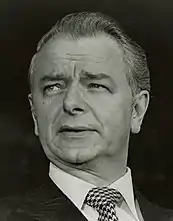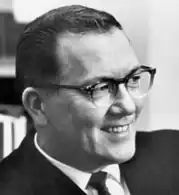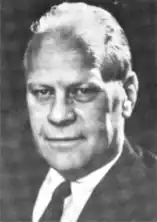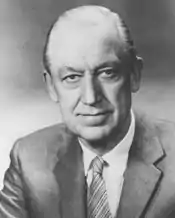92nd United States Congress
The 92nd United States Congress was a meeting of the legislative branch of the United States federal government, composed of the United States Senate and the United States House of Representatives. It met in Washington, D.C., from January 3, 1971, to January 3, 1973, during the third and fourth years of Richard Nixon's presidency.
| 92nd United States Congress | |
|---|---|
91st ← → 93rd | |
 | |
January 3, 1971 – January 3, 1973 | |
| Members | 100 senators 435 representatives |
| Senate majority | Democratic |
| Senate President | Spiro Agnew (R) |
| House majority | Democratic |
| House Speaker | Carl Albert (D) |
| Sessions | |
| 1st: January 21, 1971 – December 17, 1971 2nd: January 18, 1972 – October 18, 1972 | |
The apportionment of seats in this House of Representatives was based on the 1960 census. Both chambers maintained a Democratic majority.
Major events
Passing legislation on revenue-sharing was a key event of the congress. President Richard Nixon had it listed on his list of top policies to cover for the year. Nixon signed the bill into law at Independence Hall in Philadelphia. The law gained support from many state and local officials including: San Francisco Mayor Joseph Alioto whose city received $27 million in revenue-sharing money in the first year. Alioto said that many projects that would not have been possible could now be done, "That will effectively enable us to meet those programs which up to now because of very tough budgeting we've had to trench."[1]
Major legislation
- December 18, 1971: Alaska Native Claims Settlement Act, Pub. L.Tooltip Public Law (United States) 92–203, 85 Stat. 688
- December 23, 1971: National Cancer Act, Pub. L.Tooltip Public Law (United States) 92–218, 85 Stat. 778
- February 7, 1972: Federal Election Campaign Act, Pub. L.Tooltip Public Law (United States) 92–225, 86 Stat. 3
- March 24, 1972: Equal Employment Opportunity Act, Pub. L.Tooltip Public Law (United States) 92–261, 86 Stat. 103
- June 23, 1972: Title IX Amendment of the Higher Education Act, Pub. L.Tooltip Public Law (United States) 92–318, 86 Stat. 235
- October 6, 1972: Federal Advisory Committee Act, Pub. L.Tooltip Public Law (United States) 92–463, 86 Stat. 770
- October 18, 1972: Federal Water Pollution Control Amendments of 1972, Pub. L.Tooltip Public Law (United States) 92–500, 86 Stat. 816
- October 21, 1972: Marine Mammal Protection Act, Pub. L.Tooltip Public Law (United States) 92–522, 86 Stat. 1027
- October 27, 1972: Consumer Product Safety Act, Pub. L.Tooltip Public Law (United States) 92–573, 86 Stat. 1207
- October 27, 1972: Noise Control Act, Pub. L.Tooltip Public Law (United States) 92–574, 86 Stat. 1234
- October 27, 1972: Coastal Zone Management Act, Pub. L.Tooltip Public Law (United States) 92–583, 86 Stat. 1280
Constitutional amendments
- March 23, 1971: Approved an amendment to the United States Constitution prohibiting the states and the federal government from using age as a reason for denying the right to vote to citizens of the United States who are at least eighteen years old, and submitted it to the state legislatures for ratification
- July 1, 1971: The Twenty-sixth Amendment to the United States Constitution was ratified by the requisite number of states (38) to become part of the Constitution
- March 22, 1972: Approved an amendment to the Constitution designed to guarantee equal rights for women, and submitted it to the state legislatures for ratification
- This amendment, commonly known as the Equal Rights Amendment, was later rendered inoperative, as it was not ratified within the seven–year time frame set by Congress (nor the later time extension granted)
Party summary
The count below identifies party affiliations at the beginning of the first session of this Congress, and includes members from vacancies and newly admitted states, when they were first seated. Changes resulting from subsequent replacements are shown below in the Changes in membership section.
Senate

| Party (shading shows control) |
Total | Vacant | |||
|---|---|---|---|---|---|
| Democratic (D) |
Republican (R) | Other (O) | |||
| End of previous congress | 59 | 41 | 0 | 100 | 0 |
| Begin | 54 | 44 | 2 | 100 | 0 |
| End | |||||
| Final voting share | 54.0% | 44.0% | 2.0% | ||
| Beginning of next congress | 56 | 42 | 2[lower-alpha 1] | 100 | 0 |
House of Representatives
| Party (shading shows control) |
Total | Vacant | ||
|---|---|---|---|---|
| Democratic (D) |
Republican (R) | |||
| End of previous congress | 242 | 189 | 431 | 4 |
| Begin | 254 | 180 | 434 | 1 |
| End | 252 | 178 | 430 | 5 |
| Final voting share | 58.6% | 41.4% | ||
| Beginning of next congress | 241 | 192 | 433 | 2 |
Leadership
Senate
- President: Spiro Agnew (R)
- President pro tempore:
- Richard Russell Jr. (D), until January 21, 1971
- Allen J. Ellender (D), January 22, 1971 – July 27, 1972
- James Eastland (D), from July 28, 1972
- Permanent Acting President pro tempore: Lee Metcalf (D)
Majority (Democratic) leadership
Minority (Republican) leadership
House of Representatives
- Speaker: Carl Albert (D)
Majority (Democratic) leadership
Minority (Republican) leadership
- Minority Leader: Gerald Ford
- Minority Whip: Leslie C. Arends
- Republican Conference Chairman: John B. Anderson
- Republican Conference Vice-Chairman: Robert Stafford then Samuel L. Devine
- Republican Conference Secretary: Richard H. Poff then Jack Edwards
- Policy Committee Chairman: John Jacob Rhodes
- Republican Campaign Committee Chairman: Bob Wilson
Members
This list is arranged by chamber, then by state. Senators are listed in order of class, and representatives are listed by district.
Senate
Senators are popularly elected statewide every two years, with one-third beginning new six-year terms with each Congress. Preceding the names in the list below are Senate class numbers, which indicate the cycle of their election. In this Congress, Class 1 meant their term began with this Congress, requiring reelection in 1976; Class 2 meant their term ended with this Congress, requiring reelection in 1972; and Class 3 meant their term began in the last Congress, requiring reelection in 1974.
House of Representatives
The names of members of the House of Representatives are preceded by their district numbers.
Changes in membership
The count below reflects changes from the beginning of the first session of this Congress.
Senate
- Replacements: 5
- Democratic: no net change
- Republican: no net change
- Deaths: 3
- Resignations: 0
- Total seats with changes: 3
| State (class) |
Vacated by | Reason for change | Successor | Date of successor's formal installation[lower-alpha 2] |
|---|---|---|---|---|
| Georgia (2) |
Richard Russell Jr. (D) | Died January 21, 1971 | David H. Gambrell (D) | February 1, 1971 |
| Vermont (1) |
Winston L. Prouty (R) | Died September 10, 1971 | Robert Stafford (R) | September 16, 1971 |
| Louisiana (2) |
Allen J. Ellender (D) | Died July 27, 1972 | Elaine S. Edwards (D) | August 1, 1972 |
| Georgia (2) |
David H. Gambrell (D) | Successor elected November 7, 1972 | Sam Nunn (D) | November 8, 1972 |
| Louisiana (2) |
Elaine S. Edwards (D) | Successor elected November 13, 1972 | J. Bennett Johnston (D) | November 14, 1972 |
House of Representatives
- Replacements: 10
- Democratic: no net loss
- Republican: no net gain
- Deaths: 8
- Resignations: 6
- Total seats with changes: 16
| District | Vacated by | Reason for change | Successor | Date of successor's formal installation[lower-alpha 2] |
|---|---|---|---|---|
| District of Columbia at-large | Vacant | District elected first delegate since the seat was re-established during previous congress | Walter Fauntroy (D) | March 23, 1971 |
| South Carolina 1st | Vacant | Rep. L. Mendel Rivers died during previous congress | Mendel Jackson Davis (D) | April 27, 1971 |
| Maryland 1st | Rogers Morton (R) | Resigned January 29, 1971, after being appointed United States Secretary of the Interior | William Oswald Mills (R) | May 25, 1971 |
| Pennsylvania 18th | Robert J. Corbett (R) | Died April 25, 1971 | John Heinz (R) | November 2, 1971 |
| Vermont at-large | Robert Stafford (R) | Resigned after being appointed to the US Senate September 16, 1971 | Richard W. Mallary (R) | January 7, 1972 |
| Kentucky 6th | John C. Watts (D) | Died September 24, 1971 | William P. Curlin Jr. (D) | December 4, 1971 |
| Pennsylvania 27th | James G. Fulton (R) | Died October 6, 1971 | William Sheldrick Conover (R) | April 25, 1972 |
| Illinois 15th | Charlotte Thompson Reid (R) | Resigned October 7, 1971, after being appointed to the Federal Communications Commission | Cliffard D. Carlson (R) | April 4, 1972 |
| Alabama 3rd | George W. Andrews (D) | Died December 25, 1971 | Elizabeth B. Andrews (D) | April 4, 1972 |
| Massachusetts 5th | F. Bradford Morse (R) | Resigned May 1, 1972, after being appointed Undersecretary General for Political and General Assembly Affairs at the United Nations | Vacant | Not filled this congress |
| Louisiana 7th | Edwin Edwards (D) | Resigned after being elected Governor of Louisiana May 9, 1972 | John Breaux (D) | September 30, 1972 |
| Virginia 6th | Richard Harding Poff (R) | Resigned after being appointed as a judge of the Supreme Court of Virginia | M. Caldwell Butler (R) | November 7, 1972 |
| New York 20th | William Fitts Ryan (D) | Died September 17, 1972. | Vacant | Not filled this congress |
| Ohio 16th | Frank T. Bow (R) | Died November 13, 1972. | ||
| Illinois 6th | George W. Collins (D) | Died in a plane crash December 8, 1972. | ||
| Alaska at-large | Nick Begich (D) | He and Hale Boggs were lost in a plane crash October 16, 1972. Presumptive death certificate for Rep. Begich was issued December 29, 1972. |
Committees
Lists of committees and their party leaders for members of the House and Senate committees can be found through the Official Congressional Directory at the bottom of this article. The directory after the pages of terms of service lists committees of the Senate, House (Standing with Subcommittees, Select and Special) and Joint and, after that, House/Senate committee assignments. On the committees section of the House and Senate in the Official Congressional Directory, the committee's members on the first row on the left side shows the chairman of the committee and on the right side shows the ranking member of the committee.
Senate
- Aeronautical and Space Sciences (Chair: Clinton P. Anderson; Ranking Member: Carl T. Curtis)
- Agriculture and Forestry (Chair: Herman E. Talmadge; Ranking Member: Jack Miller)
- Appropriations (Chair: Allen J. Ellender; Ranking Member: Milton R. Young)
- Armed Services (Chair: John C. Stennis; Ranking Member: Margaret Chase Smith)
- Banking, Housing and Currency (Chair: John J. Sparkman; Ranking Member: John G. Tower)
- Commerce (Chair: Warren G. Magnuson; Ranking Member: Norris Cotton)
- District of Columbia (Chair: Thomas F. Eagleton; Ranking Member: Charles Mathias)
- Equal Educational Opportunity (Select) (Chair: Walter Mondale)
- Finance (Chair: Russell B. Long; Ranking Member: Wallace F. Bennett)
- Foreign Relations (Chair: J. William Fulbright; Ranking Member: George D. Aiken)
- Government Operations (Chair: John Little McClellan; Ranking Member: Karl E. Mundt)
- Interior and Insular Affairs (Chair: Henry M. Jackson; Ranking Member: Gordon Allott)
- Judiciary (Chair: James O. Eastland; Ranking Member: Roman L. Hruska)
- Labor and Public Welfare (Chair: Harrison A. Williams; Ranking Member: Jacob K. Javits)
- Nutrition and Human Needs (Select) (Chair: George McGovern)
- Post Office and Civil Services (Chair: Gale W. McGee; Ranking Member: Hiram L. Fong)
- Public Works (Chair: Jennings Randolph; Ranking Member: John Sherman Cooper)
- Rules and Administration (Chair: B. Everett Jordan; Ranking Member: Winston L. Prouty)
- Secret and Confidential Government Documents (Special) (Chair: [data missing]; Ranking Member: [data missing])
- Small Business (Select) (Chair: Alan Bible)
- Standards and Conduct (Select) (Chair: John C. Stennis; Vice Chair: Wallace F. Bennett)
- Subcommittee on Veterans' Affairs (Chair: Vance Hartke; Ranking Member: Strom Thurmond)
- Whole
House of Representatives
- Agriculture (Chair: William R. Poage; Ranking Member: Page Belcher)
- Appropriations (Chair: George H. Mahon; Ranking Member: Frank T. Bow)
- Armed Services (Chair: F. Edward Hebert; Ranking Member: Leslie C. Arends)
- Banking and Currency (Chair: Wright Patman; Ranking Member: William B. Widnall)
- Crime (Select) (Chair: Claude Pepper)
- District of Columbia (Chair: John L. McMillan; Ranking Member: Ancher Nelsen)
- Education and Labor (Chair: Carl D. Perkins; Ranking Member: Al Quie)
- Foreign Affairs (Chair: Thomas E. Morgan; Ranking Member: William S. Mailliard)
- Government Operations (Chair: Chet Holifield; Ranking Member: Florence P. Dwyer)
- House Administration (Chair: Wayne L. Hays; Ranking Member: Samuel L. Devine)
- House Beauty Shop (Select) (Chair: Martha W. Griffiths)
- House Restaurant (Select) (Chair: John C. Kluczynski)
- Interior and Insular Affairs (Chair: Wayne N. Aspinall; Ranking Member: John P. Saylor)
- Internal Security (Chair: Richard H. Ichord; Ranking Member: John M. Ashbrook)
- Interstate and Foreign Commerce (Chair: Harley O. Staggers; Ranking Member: William L. Springer)
- Judiciary (Chair: Emanuel Celler; Ranking Member: William M. McCulloch)
- Merchant Marine and Fisheries (Chair: Emanuel Celler; Ranking Member: Thomas M. Pelly)
- Post Office and Civil Service (Chair: Edward A. Garmatz; Ranking Member: Robert J. Corbett)
- Public Works (Chair: John A. Blatnik; Ranking Member: Bill Harsha)
- Regulate Parking (Select) (Chair: B.F. Sisk)
- Rules (Chair: William M. Colmer; Ranking Member: H. Allen Smith)
- Science and Astronautics (Chair: George P. Miller; Ranking Member: James G. Fulton)
- Small Business (Select) (Chair: Joe L. Evins)
- Standards of Official Conduct (Chair: Charles Melvin Price; Ranking Member: Jackson E. Betts)
- Veterans' Affairs (Chair: Olin E. Teague; Ranking Member: Charles M. Teague)
- Ways and Means (Chair: Wilbur D. Mills; Ranking Member: John W. Byrnes)
- Whole
Joint committees
- Atomic Energy (Chair: Sen. John O. Pastore; Vice Chair: Rep. Charles Melvin Price)
- Congressional Operations (Chair: Rep. Jack Brooks; Vice Chair: Sen. Lee Metcalf)
- Defense Production (Chair: Rep. Wright Patman; Vice Chair: Sen. John J. Sparkman)
- Economic (Chair: Sen. William Proxmire; Vice Chair: Rep. Wright Patman)
- The Library (Chair: Rep. Wayne L. Hays; Vice Chair: Sen. B. Everett Jordan)
- Navajo-Hopi Indian Administration
- Printing (Chair: N/A)
- Reduction of Nonessential Federal Expenditures (Chair: Rep. George H. Mahon)
- Taxation (Chair: Rep. Wilbur D. Mills; Vice Chair: Sen. Russell B. Long)
Employees
Legislative branch agency directors
- Architect of the Capitol: George M. White, appointed January 27, 1971
- Attending Physician of the United States Congress: Rufus Pearson
- Comptroller General of the United States: Elmer B. Staats
- Librarian of Congress: Lawrence Quincy Mumford
- Public Printer of the United States: Adolphus N. Spence, until 1972
Senate
- Chaplain: Edward L.R. Elson (Presbyterian)
- Curator: James R. Ketchum
- Parliamentarian: Floyd Riddick
- Secretary: Francis R. Valeo
- Librarian: Richard D. Hupman
- Democratic Party Secretary: J. Stanley Kimmitt
- Republican Party Secretary: J. Mark Trice
- Sergeant at Arms: Robert G. Dunphy, until June 30, 1972 (resigned)
- William H. Wannall, from July 1, 1972
House of Representatives
- Clerk: W. Pat Jennings
- Sergeant at Arms: Zeake W. Johnson Jr., January 21, 1971 – September 30, 1972 (resigned)
- Kenneth R. Harding, from October 1, 1972
- Doorkeeper: William M. Miller
- Postmaster: H. H. Morris, January 21, 1971 – June 30, 1972 (resigned)
- Robert V. Rota, from July 1, 1972
- Parliamentarian: Lewis Deschler
- Reading Clerks:
- Joe Bartlett (until 1971) (R), Bob Berry (starting 1971) (R)
- Charles W. Hackney Jr. (D)
- Chaplain: Edward G. Latch (Methodist)
Footnotes
- Martis, Kenneth C. (1989). The Historical Atlas of Political Parties in the United States Congress. New York: Macmillan Publishing Company.
- Martis, Kenneth C. (1982). The Historical Atlas of United States Congressional Districts. New York: Macmillan Publishing Company.
See also
- 1970 United States elections (elections leading to this Congress)
- 1972 United States elections (elections during this Congress, leading to the next Congress)
Notes
- Conservative Party of New York, Independent
- When seated or oath administered, not necessarily when service began.
References
External links
- House of Representatives Session Calendar for the 92nd Congress (PDF). Archived from the original (PDF) on December 24, 2016. Retrieved June 6, 2016.
- Congressional Pictorial Directory for the 92nd Congress.
- Official Congressional Directory for the 92nd Congress, 1st Session.
- Official Congressional Directory for the 92nd Congress, 2nd Session.

.jpg.webp)




.jpg.webp)

